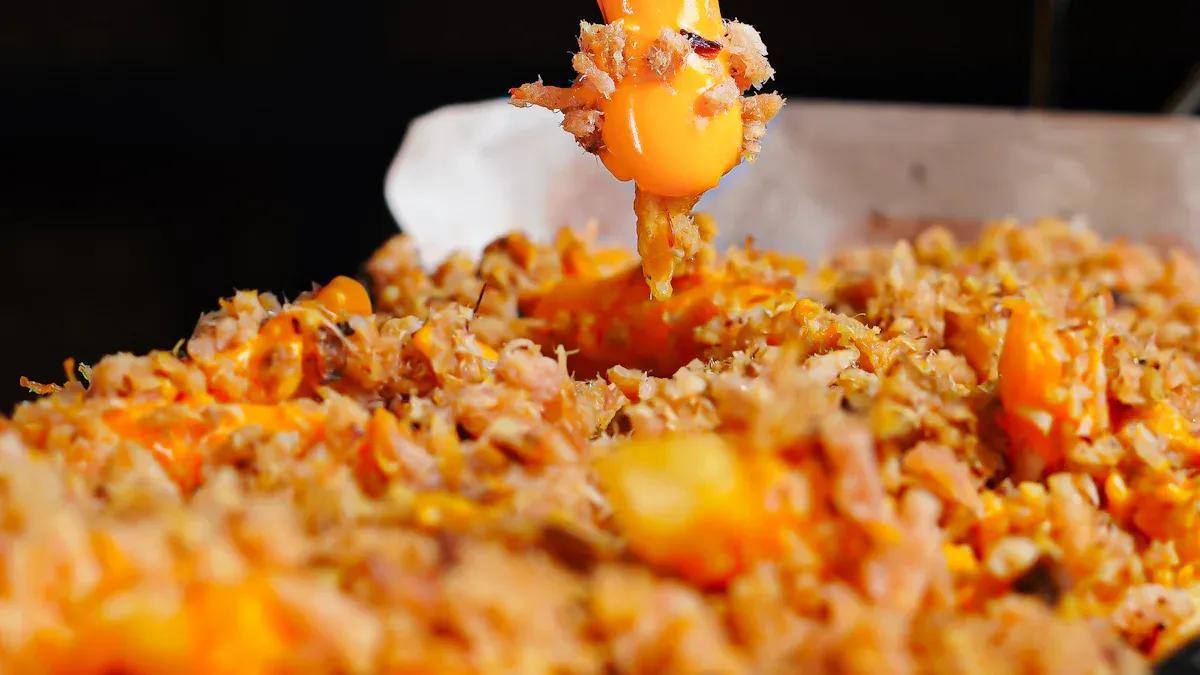
Tempura powder is not just for shrimp. You can make crunchy cheese sticks or soft avocado bites. You can also try ice-cream tempura, which is a new trend. Get some tempura powder at home and be creative. Try new flavors and textures in your kitchen. Don’t worry about making mistakes.
Key Takeaways
- Tempura powder can be used in many ways. You can make crunchy cheese sticks with it. Try making creamy avocado bites too. You can even fry ice cream with tempura powder.
- It is easy to make tempura batter at home. Mix flour, egg, and cold water together. This gives you a light and crispy coating. Be careful not to mix too much!
- If you want gluten-free tempura, use rice flour instead of regular flour. You can still make tasty tempura without gluten.
Surprising Foods with Tempura Powder
Tempura Cheese Sticks
Tempura powder can make cheese sticks crunchy and fun. The batter is lighter and crispier than normal breading. If you use ice water and hot oil, your tempura will turn out great. Look at this table to see what makes tempura batter special:
|
Technique |
Benefit |
|---|---|
|
Avoiding gluten development |
Lighter, crispier texture |
|
Using ice water |
Keeps batter cold and crispy |
|
Hot oil |
Makes cheese sticks extra crunchy |
Dip the cheese sticks in batter. Fry them until they look golden. Eat them with Pearl River Bridge teriyaki sauce.
Tempura Avocado
Tempura powder works well on vegetables like avocado. The inside stays creamy, and the outside gets crispy. To make the batter, mix these things:
|
Ingredient |
Quantity |
|---|---|
|
Egg |
1 |
|
Ice water |
To mix |
|
All-purpose flour |
Heaping tbsp |
|
Baking powder |
To mix |
Cut the avocado into slices. Dip each slice in the batter. Fry them and serve with ponzu sauce for a tangy dip.
Tempura Ice Cream
You can even use tempura powder for ice cream. Wrap a scoop of ice cream in bread and freeze it. Dip it in homemade tempura batter and fry it fast. The outside is hot and crispy, but the ice cream inside stays cold and soft.
Tempura Pickles
Tempura pickles are a cool snack. Dip pickle slices in batter and fry them. The batter keeps them crunchy. Try them with Pearl River Bridge kimchi sauce for more flavor.
Creative Tempura Tips
Tempura powder is not just for shrimp or Japanese tempura. Try it with mushrooms, sweet potatoes, or apple slices. Always use ice water for the batter. For the best tempura, keep everything cold. Japanese tempura should be light and crunchy. Eat your crispy tempura with Pearl River Bridge Japanese Seasoning sauces for a tasty meal.
Tempura powder can be used in lots of ways. Try making something new at home and find your favorite. You might be surprised by what you can make with it, like:
-
Cheese tempura (people love it, especially with Camembert and honey)
-
Avocado, ice cream, and pickles
Keep these tips in mind for crispy food. Check out Pearl River Bridge’s Japanese Seasoning collection for real Japanese flavors.
FAQ
Can I use tempura batter for sweet foods?
Yes! You can dip fruits or even ice cream in tempura batter. This gives you a crispy outside and a soft, sweet inside.
What oil works best for frying tempura powder recipes?
Use vegetable oil or canola oil. These oils help your tempura batter stay light and crispy. Always keep the oil hot for the best crunch.
How do I store leftover tempura powder?
Keep your tempura powder in an airtight container. Store it in a cool, dry place. This keeps it fresh for your next tempura adventure.

You can make eating fermented foods part of your daily routine without any stress. Pearl River Bridge brings you real flavor and tradition right to your kitchen. Fermented foods taste bold and delicious, and they help your body with probiotics and nutrients. You might love the way fermented foods wake up your taste buds. Try eating fermented foods with your breakfast, lunch, or even as a snack. You will discover how easy it feels to enjoy fermented foods every day.
Discovering Fermented Foods and Their Health Benefits
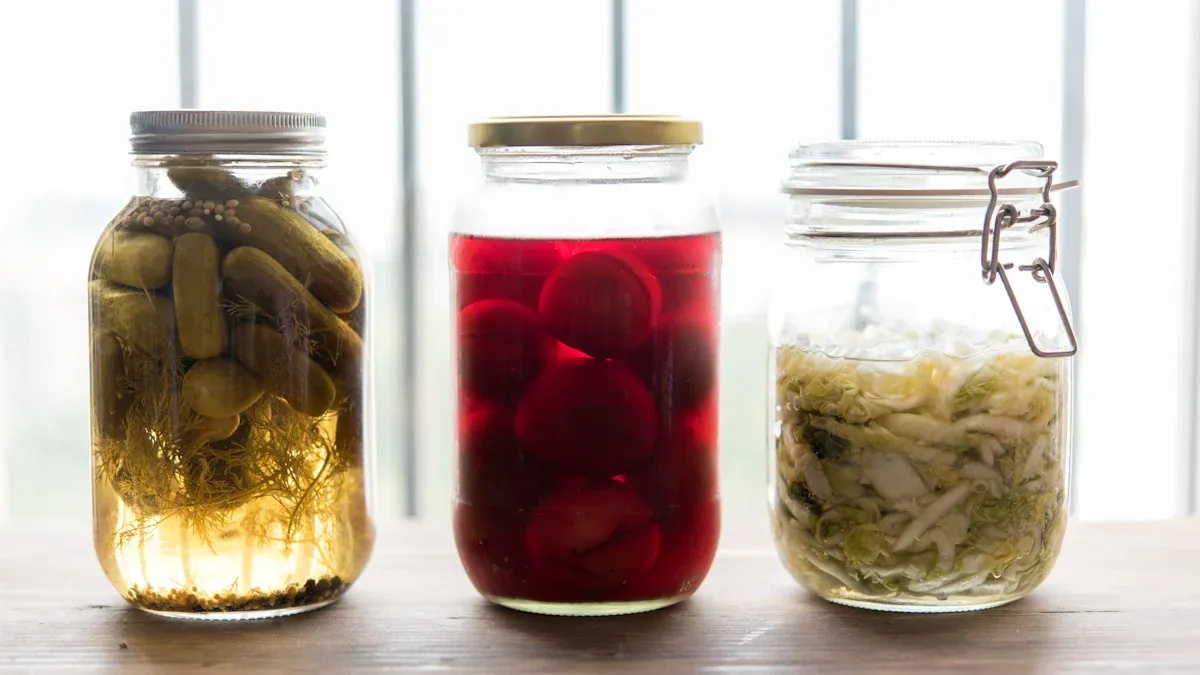
What Are Fermented Foods?
Fermented foods are made in a special way. Good bacteria change the sugars and starches in the food. This makes the food taste strong and gives it a different feel. People from many places eat fermented foods. Yogurt, kimchi, sauerkraut, and miso are some examples. Pearl River Bridge has many kinds of fermented foods. You can buy Fermented Red Beancurd, Preserved Beans, and Canned Fish. Each one adds something new to your meals.
Health Benefits of Fermented Foods
Fermented foods are not just tasty. They help your body in many ways. When you eat them, you get probiotics. These are good bacteria that help your stomach. You might feel your digestion improve and your immune system get stronger. Some people feel more energy when they eat fermented foods often. These health benefits make fermented foods a smart choice for your meals.
Flavor and Tradition in Pearl River Bridge Products
Pearl River Bridge makes fermented foods using old methods. You can taste the tradition in every bite. Fermented Red Beancurd gives your food a strong smell and color. Preserved Beans add a deep soy sauce taste. Canned Fish with salted black beans is easy and tasty. When you use Pearl River Bridge fermented foods, you get real flavors and a bit of history. You can try easy recipes or just add a little to your favorite food. There are many ways to enjoy them.
Cooking with Fermented Foods for Every Meal
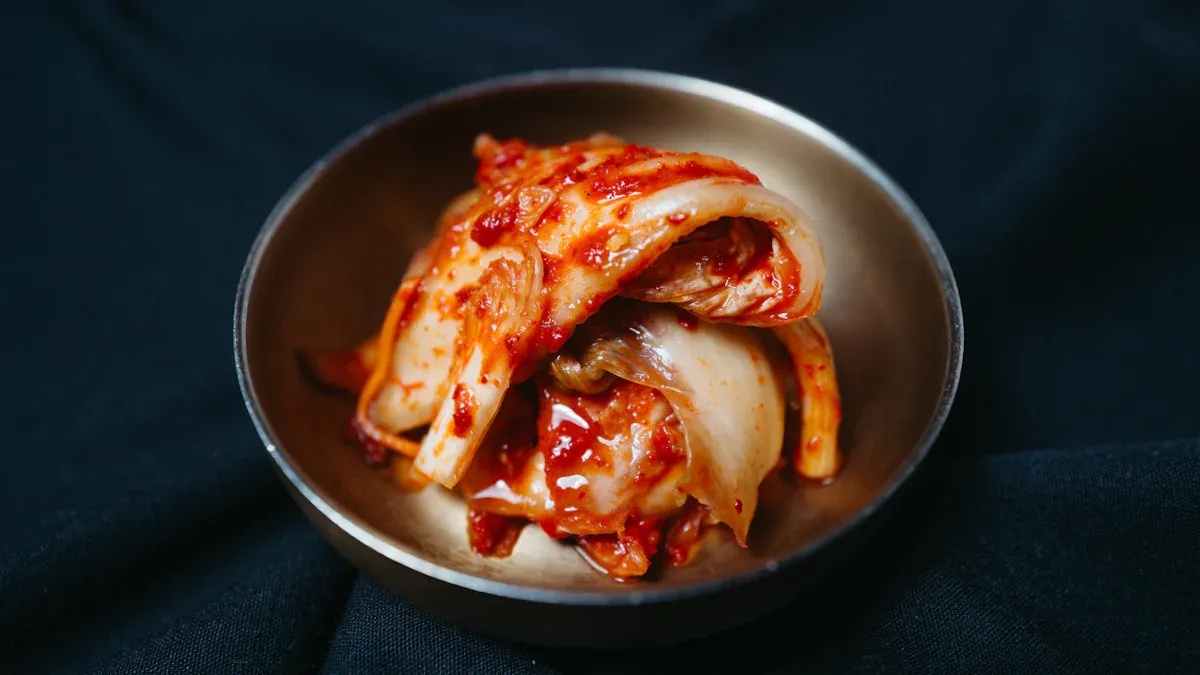
Breakfast: Easy Ways to Start Eating Fermented Foods
You can start your day with a burst of flavor by adding fermented foods to your breakfast. Try spreading a small amount of Pearl River Bridge Fermented Red Beancurd on toast. The creamy texture and bold taste wake up your senses. If you like eggs, mix a spoonful of sauerkraut into your scrambled eggs. The tangy crunch makes every bite exciting. Some people enjoy kimchi with their morning rice or even in a breakfast burrito. You can also stir a bit of preserved beans into your oatmeal for a savory twist. These simple ideas help you enjoy fermented food in meals right from the start of your day.
Lunch: Quick Cooking with Fermented Vegetables and Beans
Lunch is the perfect time for adding fermented vegetables to your plate. You can toss sauerkraut into a salad for extra crunch. Try making a quick sandwich with sliced turkey, cheese, and a layer of kimchi. The spicy kick from the kimchi pairs well with the mild flavors. If you like noodles, add some Pearl River Bridge Preserved Beans and a handful of sauerkraut to your bowl. You can also try cooking fermented vegetables in a simple stir-fry. Just add them at the end so the fermented vegetables taste stays fresh and bright.
Dinner: Elevate Your Cooking with Fermented Sauces and Canned Fish
Dinner gives you a chance to try new flavors and recipes. Pearl River Bridge Canned Fish, like fried dace with salted black beans, makes a quick and tasty meal. You can serve it over steamed rice or mix it into a noodle bowl. For a cozy night, try making fermented beet soup. Add a spoonful of sauerkraut and a bit of kimchi to your soup pot. The flavors blend together and create something special. You can also use fermented chili beancurd paste as a dipping sauce for dumplings or roasted meats. Cooking with fermented foods at dinner helps you explore new tastes and traditions.
Snacks: Creative Ideas for Eating Fermented Foods
Snacks are a great way to enjoy fermented foods between meals. You can eat sauerkraut straight from the jar or pile it on crackers. Kimchi makes a spicy topping for avocado toast. If you want something crunchy, try Pearl River Bridge Sliced Mustard Tuber with rice cakes. You can even mix preserved beans into hummus for a salty, rich flavor. These snacks are easy to make and full of probiotics.
Here’s a quick snack idea:
- Top a small bowl of rice with kimchi and a drizzle of soy sauce. Add a few slices of cucumber for crunch.
You can see how adding fermented foods to your snacks keeps things interesting and tasty.
Tips for Cooking Fermented Vegetables and More
Simple Cooking Techniques
You can cook with fermented foods in many easy ways. Try adding a spoonful of Pearl River Bridge Fermented Red Beancurd to stir-fries. The flavor blends quickly with vegetables and meat. If you want a fast side dish, mix sauerkraut with sliced apples. Heat them together for a sweet and tangy treat. You can also mash preserved beans and spread them on toast. Cooking with fermented foods does not need fancy steps. Just add them near the end of cooking to keep their taste fresh.
Pairing Flavors with Fermented Foods
Fermented foods have bold flavors. You can pair them with mild foods like rice, noodles, or eggs. Try mixing kimchi with scrambled eggs for breakfast. Serve canned fish with plain steamed rice. If you want more crunch, add sliced mustard tuber to salads. You can also use fermented chili beancurd paste as a dip for fresh veggies. Here’s a table with pairing ideas:
| Fermented Food | Good Pairings |
| Fermented Red Beancurd | Stir-fried greens |
| Preserved Beans | Noodles, rice |
| Canned Fish | Steamed rice, veggies |
| Sliced Mustard Tuber | Salads, rice cakes |
Storing and Using Pearl River Bridge Products
You can keep most fermented foods in the fridge after opening. Make sure you close the lid tightly. This keeps the flavors fresh and stops them from drying out. If you use canned fish, store leftovers in a sealed container. Preserved beans and beancurd last a long time if you keep them cool and dry. Always check the label for storage tips. You will find that Pearl River Bridge products stay tasty for many meals.
FAQ
What are some common types of fermented foods I can add to my meals?
You can try yogurt, sourdough, salsa, lacto-fermented salsa, fermented hot sauce, and even add them to your salad. These foods taste great and help your body. You can find many of these in stores or make them at home.
How do I use salsa and lacto-fermented salsa in my daily meals?
You can spoon salsa or lacto-fermented salsa over eggs, mix them into your salad, or use them as a dip. Try adding salsa to tacos or even on top of sourdough toast for a quick snack.
Can I add fermented hot sauce to my salad or other foods?
Yes! Drizzle fermented hot sauce over your salad, tacos, or even pizza. You can also mix it into salsa for extra heat. Fermented hot sauce brings a tangy kick to sourdough sandwiches and yogurt bowls.
How can I enjoy yogurt and sourdough together?
You can spread yogurt on sourdough toast and top it with salsa. Try making a salad with torn sourdough, yogurt dressing, and a spoonful of lacto-fermented salsa. This combo tastes fresh and gives you lots of good bacteria.
What are some easy ways to add more fermented foods like salsa and salad to my snacks?
- Dip sourdough in salsa or lacto-fermented salsa.
- Top your salad with yogurt and fermented hot sauce.
- Make a quick snack with sourdough, salsa, and a side of yogurt.
Low sodium soy sauce gives you a way to add rich flavor to your meals while keeping your sodium intake in check. You can use it to boost the taste of your favorite dishes and discover new recipes that support your health goals. Try mixing it into simple stir-fries or using it as a dip. Feel free to experiment and find what works best for you.
What Is Low Sodium Soy Sauce
Key Differences from Regular Soy Sauce
Low Sodium Soy Sauce gives you a flavorful option for your kitchen. You get the same rich aroma and savory taste as regular soy sauce, but with much less salt. Producers make low sodium soy sauce by first brewing regular soy sauce. They then use a desalination process to lower the salt content, so you can enjoy the classic umami flavor without the extra sodium.
- Low sodium soy sauce contains less than 9 grams of sodium per 100 grams.
- You get about 35% less salt compared to regular soy sauce.
- Regular soy sauce uses soybeans, wheat, water, and salt, and ferments for several months. Low sodium soy sauce goes through an extra step to reduce salt.
If you want to cook healthier meals, you can swap regular soy sauce for low sodium soy sauce in most recipes. You still get the deep, savory notes that make Asian dishes so delicious.
Health Benefits and Dietary Suitability
Choosing Gluten Free Low Salt Soy Sauce helps you manage your sodium intake. Many people look for ways to lower their salt consumption, especially if they watch their blood pressure or heart health. Regular light soy sauce can have between 900mg and 1,200mg of sodium per tablespoon. Low sodium soy sauce offers 25% to 50% less sodium, making it a smart choice for health-conscious cooks.
- Low sodium soy sauce fits well into vegan diets.
- You can use it if you want to reduce sodium but keep the flavor in your meals.
- The term "low-sodium" means the product is made to have less salt, not just a lighter color or thinner texture.
Low sodium soy sauce lets you enjoy bold flavors while supporting your health goals. You can feel confident using it in everyday cooking, whether you follow a vegan lifestyle or simply want to make better choices for your family.
Ways to Use Low Sodium Soy Sauce
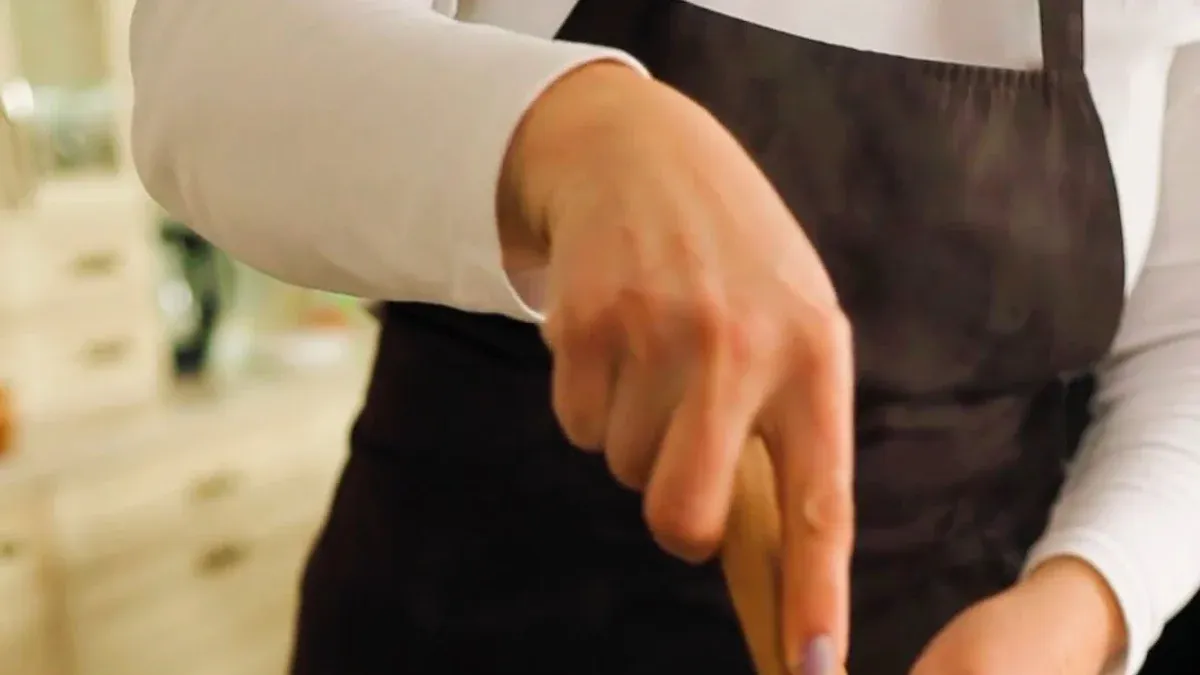
Everyday Cooking Ideas
You can use low sodium soy sauce in many everyday dishes to boost flavor without adding too much salt. This sauce works well in both Asian and non-Asian recipes. Try adding a splash to your morning scrambled eggs or drizzle it over steamed vegetables for a savory kick. Many home cooks use it in soups, stews, and even chili to deepen the umami taste.
Some popular dishes that benefit from low sodium soy sauce include:
- Chili: Add a dash to enhance the umami depth.
- Filipino Chicken Adobo: Combine with vinegar for a salty, tangy flavor.
- Sushi: Use as a dip for a lighter, healthier option.
- Stir-fries: Toss with vegetables, tofu, or chicken for a quick meal.
- Soups: Stir into broths for extra richness.
A small bottle of Less Salt Soy Sauce 150ml lasts a long time because the flavor is strong. You only need a little to make a big difference in your meals.
Recipe Substitutions
You can easily swap regular soy sauce for low sodium soy sauce in most recipes. For small amounts, use the same amount as you would with regular soy sauce. If a recipe calls for a large amount, start with half the amount of low sodium soy sauce. Taste your dish, then add more if needed. This method helps you control the saltiness and avoid overpowering the other flavors.
If you want a low sodium soy sauce substitute, try mixing a bit of low sodium teriyaki sauce with water or fruit juice. This blend works well in marinades and dressings when you want a milder taste.
Marinades, Stir-Fries, and Dips
Low sodium soy sauce shines in marinades, stir-fries, and dips. For best results, pre-mix your sauce before cooking. This step ensures a balanced flavor in every bite. When making a marinade, combine low sodium soy sauce with rice vinegar, a touch of honey or sugar, and a bit of chili oil for heat. Add fresh garlic and ginger for extra depth.
In stir-fries, start by cooking garlic and ginger in hot oil for about 30 seconds. Add low sodium soy sauce and vinegar when your vegetables are halfway cooked. This timing helps the flavors blend without losing freshness. Finish with a drizzle of sesame oil and a sprinkle of fresh herbs in the last minute of cooking.
When making dips, remember that a little sauce goes a long way. Aim for a glossy coating on your food rather than a soupy texture. You can balance the main flavors in your sauces by following these steps:
- Use low sodium soy sauce to control saltiness.
- Add sugar or honey for sweetness.
- Pour in rice vinegar for acidity.
- Mix in mushroom sauce for extra umami.
- Include chili oil or fresh chilies for a spicy kick.
Maximizing Flavor with Low Sodium Soy Sauce
Pairing with Acids, Herbs, and Spices
You can unlock new layers of flavor by pairing low sodium soy sauce with acids, herbs, and spices. Acids like vinegar or fruit juice brighten dishes and balance the savory notes of soy sauce. When you mix low sodium soy sauce with pineapple juice, you create a sweet, tart, and slightly salty taste that feels more satisfying than using soy sauce alone. This combination also helps reduce the overall sodium content in your meal.
- Mixing low sodium soy sauce with canned pineapple juice enhances flavor while reducing sodium content.
- The blend creates a sweet/tart and slightly salty flavor that is more satisfying than soy sauce alone.
Fresh herbs such as cilantro, basil, or green onions add freshness and complexity. Spices like ginger, garlic, or chili flakes bring warmth and depth. You can also use herb blends to replace salt, adding both flavor and beneficial nutrients. Your taste buds will adapt to lower sodium levels, so you will still enjoy bold flavors.
Enhancing Umami Taste
You can boost the umami taste of your dishes by using low sodium soy sauce in creative ways. Scientific research shows that innovative formulation strategies, such as using special emulsions, help low sodium soy sauce maintain and even enhance the perception of saltiness. This means you get the same savory depth as regular soy sauce, making your meals just as flavorful.
If you want to experiment, try using a low sodium soy sauce substitute in recipes that call for a lot of seasoning. You can mix it with mushroom sauce or a splash of tomato juice to add even more umami. Herbs and spices also help round out the flavor, so you do not miss the extra salt.
Cooking Methods for Best Results
The way you use low sodium soy sauce during cooking affects both taste and texture. Light soy sauce has a thin consistency, which makes it perfect for marinades and dressings. It forms a light layer around your ingredients, helping them absorb flavor without becoming heavy or soggy. If you add soy sauce at the right time, you can improve both the taste and the texture of your dish.
- Add low sodium soy sauce early in marinades to let flavors soak in.
- For stir-fries, add it when vegetables are halfway cooked to keep them crisp and flavorful.
- In soups or stews, stir it in near the end to preserve its aroma and umami.
If you want to adjust the saltiness, you can use a small amount of low sodium salt along with your soy sauce. This method lets you enhance flavor while keeping sodium levels low. Herbs, spices, and acids can also help you maintain a balanced taste without relying on traditional salt.
| Cooking Method | When to Add Soy Sauce | Resulting Flavor/Texture |
| Marinade | Early | Deep, well-absorbed flavor |
| Stir-fry | Midway | Bright, crisp vegetables |
| Soup/Stew | Near the end | Fresh aroma, rich umami |
Healthy Vegan Soy Sauce in Balanced Meals
Combining with Low Sodium Ingredients
You can create balanced meals by pairing healthy vegan soy sauce with other low sodium ingredients. This approach helps you enjoy bold flavors while keeping your sodium intake in check. When you cook at home, you control what goes into your food. You can use fresh vegetables, whole grains, and plant-based proteins to build a nutritious plate. Try adding these ingredients to your meals:
- No salt added vegetable broth
- Rice vinegar or apple cider vinegar
- Unsweetened pineapple juice
- Garlic and ginger
- Bell peppers, broccoli, snap peas, mushrooms, zucchini
- Tofu, edamame, or tempeh
- Brown rice, jasmine rice, or cauliflower rice
Cooking with these foods and healthy vegan soy sauce lets you reduce sodium from additives and preservatives. You also boost your intake of fiber, vitamins, and minerals. Soy-based foods provide heart-healthy polyunsaturated fat and protein, making them excellent for plant-based diets.
Tips for Healthier Cooking
You can make your meals healthier by using simple strategies. Choose low sodium soy sauce to enhance flavor without adding too much salt. Use herbs, spices, and acids like lemon or lime juice to brighten dishes. Nutritionists recommend using alternatives such as Bragg’s Amino Acids for a strong flavor with less sodium.
Cooking at home gives you the power to control sodium. You can see real results in sodium reduction when you use low sodium soy sauce. For example:
| Dish Type | Sodium Reduction (%) |
| Salad Dressing | 50% |
| Tomato Soup | 17% |
| Pan-Fried Pork | 29% |
Storage and Freshness
Proper storage keeps your healthy vegan soy sauce fresh and flavorful. After opening, place the bottle in the refrigerator. Cold temperatures slow down oxidation, which helps preserve taste and color. This practice is especially important for naturally brewed and low sodium blends. You can expect your soy sauce to stay fresh for about 6 months to 2-3 years in the fridge, but for the best flavor, try to use it within 6 to 12 months. Always check the label for specific storage instructions and expiration dates.
By combining low sodium ingredients, following healthy cooking tips, and storing your soy sauce correctly, you can enjoy delicious, balanced vegan meals every day.
You can make your meals healthier and more flavorful by choosing low salt soy sauce. This versatile ingredient works in stir-fries, soups, marinades, and dips. Try these practical tips to get the most out of your cooking:
- Use low sodium soy sauce as a salt substitute in marinades.
- Marinate with about 1/2 cup per pound of meat, seafood, tofu, or vegetables.
- Score thick cuts of meat for better flavor absorption.
- Seal ingredients in a zipper-top bag for even coating.
Experiment with new flavor pairings and enjoy the benefits of lower sodium in your daily meals. You take a step toward better health every time you make a tasty, mindful choice.
Korean BBQ Equipment List: From Korean BBQ Grills to Smokeless Systems, All in One
Opening a BBQ restaurant requires more than just great recipes. The right equipment ensures smooth operations, customer satisfaction, and compliance with safety standards. If you’re planning to start or upgrade your BBQ restaurant, here’s a complete equipment list to help you get everything done in one place.
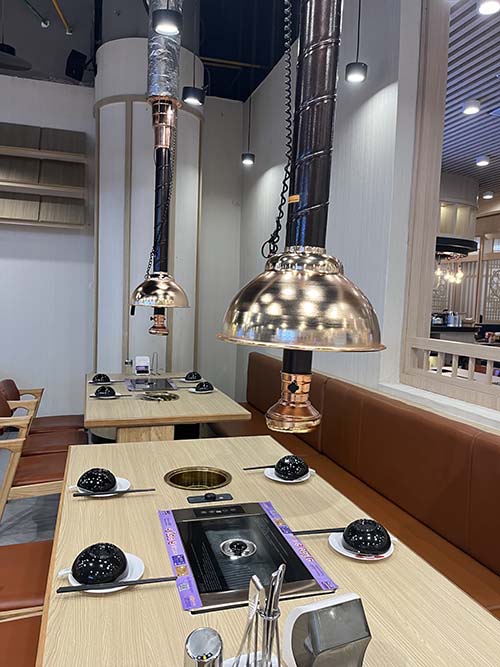
Korean BBQ Grills – The Heart of Your Restaurant
The grill is the centerpiece of any BBQ restaurant. Whether you choose charcoal grills, gas grills, or smokeless Korean BBQ grills, make sure they are durable, easy to clean, and suitable for high-volume use. Built-in grills are especially popular in modern Korean BBQ restaurants because they provide a clean and stylish dining environment.
Smokeless System – Keep the Air Clean
Good ventilation is essential for comfort and safety. BBQ pipes (exhaust hoods) installed above tables help remove smoke directly from the source. For restaurants that want a cleaner look, under-table smoke purifiers are a great option. They stay hidden while effectively capturing grease and smoke, keeping your restaurant fresh and attractive.
Korean BBQ Tables and Seating – Designed for BBQ Dining
Korean BBQ tables are specially made with built-in grills and durable surfaces. Choose heat-resistant materials that can handle daily use. For customer comfort, pair them with seating that matches your restaurant’s style—whether modern, traditional, or casual.
Safety and Energy-Saving Devices
Don’t forget fire extinguishers, non-slip mats, and energy-efficient appliances to reduce long-term costs. Investing in safe and eco-friendly equipment improves both your restaurant’s reputation and profit margins.
Why Choose a One-Stop Supplier?
Managing multiple suppliers can be stressful. By working with a one-stop BBQ and hot pot equipment supplier, you save time, reduce costs, and ensure all equipment works seamlessly together. From grills to ventilation, everything is designed to fit your restaurant’s needs.
Looking for the right BBQ or hot pot equipment for your restaurant? Contact us today — you will find more professional solutions, customized options, and reliable support to grow your business.
Hot Pot, Korean BBQ, and Combo Dining: A Complete Guide for Restaurant Owners
Hot Pot and Korean BBQ are two of the hottest dining concepts in the world today. Both bring people together, create an interactive experience, and deliver unforgettable flavors. In recent years, many restaurants have started offering Hot Pot and BBQ combo dining—a concept that combines the best of both worlds.
For restaurant owners, choosing the right hot pot table, Korean BBQ table, or hot pot and BBQ table is not just about customer enjoyment—it’s also about efficiency, profits, and long-term growth.
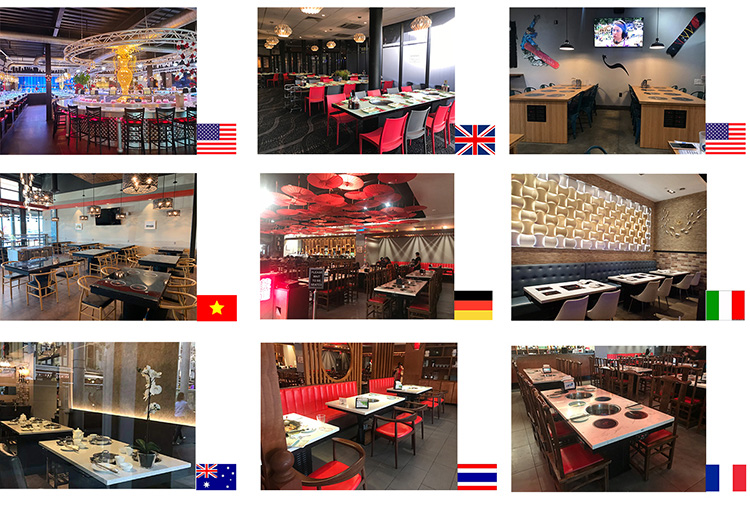
Hot Pot Restaurants: The Power of Hot Pot Tables
A hot pot table is designed to hold individual or shared hot pot soup bases, letting customers cook ingredients directly at the table.Why customers love it:
- Wide choice of broths and dipping sauces.
- Cozy, family-style dining that encourages conversation.
- Great for groups during cold seasons.
Why owners love it:
- Soup bases and dipping sauces are high-margin items.
- Customers stay longer, creating opportunities for higher per-person spending.
- Energy-efficient built-in induction cooker reduce operating costs.
Korean BBQ Restaurants: The Attraction of Korean BBQ Tables
A Korean BBQ table has a built-in grill—charcoal, gas, or smokeless—where customers cook meat themselves.
Why customers love it:
- Freshly grilled meats like samgyeopsal and bulgogi.
- Fun, sizzling cooking right at the table.
- Balanced meals with side dishes.
Why owners love it:
- Korean BBQ tables help increase table turnover because grilling is usually faster than hot pot cooking.
- Smokeless BBQ tables and strong ventilation systems improve the dining environment.
- Eye-catching grilling experiences attract younger customers and groups of friends.
Hot Pot & BBQ Combination Restaurants: The Best of Both Worlds
The hot pot and BBQ table combines a soup pot with a grill in one table, letting diners enjoy both experiences together.
Why customers love it:
- Perfect for mixed groups—some prefer grilling, others want hot pot.
- Unique dining style that makes celebrations more exciting.
- Endless variety: grill beef while cooking seafood in broth at the same time.
Why owners love it:
- Attracts a wider customer base by offering both menus.
- Higher ticket size—customers order both meats and soup bases.
- Creates a premium dining experience that supports repeat visits and loyalty.
Business Considerations for Restaurant Owners
When choosing between hot pot tables, Korean BBQ tables, and hot pot and BBQ tables, restaurant owners should consider:
Space planning: Hot pot tables work well in compact spaces, while BBQ tables need proper ventilation. Combination tables require larger areas but deliver maximum flexibility.
Ventilation systems: Korean BBQ tables need overhead or under-table smoke control. Hot pot tables need good air circulation to keep the dining room comfortable.
Profit margins: Hot pot bases and sauces bring high profit margins, while Korean BBQ drives higher turnover rates. Combination restaurants benefit from both.Target customers: Families may prefer hot pot, young groups love BBQ, and combo tables attract everyone.
Global Trends and Future Growth
Hot Pot restaurants are rapidly expanding beyond Asia into the U.S. and Europe.
Korean BBQ restaurants remain a top dining choice, especially in North America and Australia.
Combination hot pot and BBQ tables are the fastest-growing trend, with chains like KPOT in the U.S. showing how powerful this model can be.
Whether it’s the warm broths of a hot pot table, the sizzling meats on a Korean BBQ table, or the versatility of a hot pot and BBQ table, each restaurant concept has unique strengths.
For restaurant owners, investing in the right tables and equipment is not just about following a trend—it’s about creating a profitable, memorable dining experience that keeps customers coming back.
Contact us today to discuss your project and find the right equipment for your restaurant.
How Overseas Buyers Source Quality Hot Pot Equipment Easily
Hot pot restaurants are booming around the world. From Asia to North America and Europe, customers love the interactive dining experience. But for restaurant owners outside of China, one challenge often arises:how to easily source hot pot tables, hot pot induction cookers, and hot pot bases from reliable overseas suppliers.
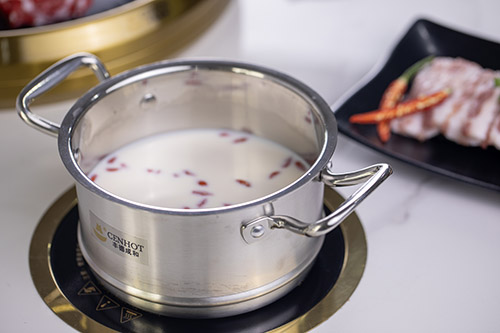
We’ll share tips and success stories that make international purchasing easier for restaurant owners and wholesalers.
Why High-Quality Hot Pot Equipment Matters
For any hot pot restaurant, the right equipment is the foundation of success:
-
Hot Pot Tables:Durable, stylish, and built for heavy commercial use. Well-designed tables also improve the dining atmosphere.
-
Hot Pot Induction Cookers:Certified and energy-efficient, they ensure safe, stable heating and lower energy costs.
-
Hot Pot Bases:The soup base is the heart of hot pot dining. High-quality bases made from natural ingredients enhance flavor and keep customers coming back.
Investing in these three essentials ensures smooth operations and a memorable customer experience.
Tips for Overseas Buyers to Buy Hot Pot Equipment
1. Work with a One-Stop Supplier
Instead of buying from multiple sources, successful overseas buyers chooseone-stop supplierswho provide hot pot tables, hot pot induction cookers, hot pot bases, and even BBQ grills. This saves time and ensures product compatibility
2. Check Certifications and Quality Control
International buyers should always confirm certifications like CE, ETL, or ULfor induction cookers. For hot pot bases, check whether the hot pot soup bases are halal certifiedor meet local standards.
3. Ask for Door-to-Door Delivery
Importing can be complicated. Choose suppliers who offerdoor-to-door deliveryso your hot pot equipment arrives directly at your restaurant or warehouse without extra hassle.
4. Customize for Your Restaurant
Every restaurant is unique. From hidden hot pot induction cookers under the table to customized soup flavors in your hot pot base, choose a supplier who can meet your specific needs.
If you are setting up your restaurant, don’t miss our hot pot tables designed for commercial use. We also provide hot pot induction cookers with CE and ETL certifications, as well as a wide range of hot pot bases to match different flavors and dining needs.
If you’re planning to open or expand your hot pot restaurant, partner with a trusted one-stop supplier. The right partner will make international purchasing simple and help you create an authentic hot pot dining experience.
Why Restaurants Need Smokeless Korean BBQ Tables
Korean BBQ has become a global dining trend, loved for its interactive style and delicious grilled dishes. However, one of the biggest challenges for restaurants is managing smoke and odors. This is where smokeless Korean BBQ tables come in. They not only improve the dining experience but also make restaurant operations more efficient and cost-effective.
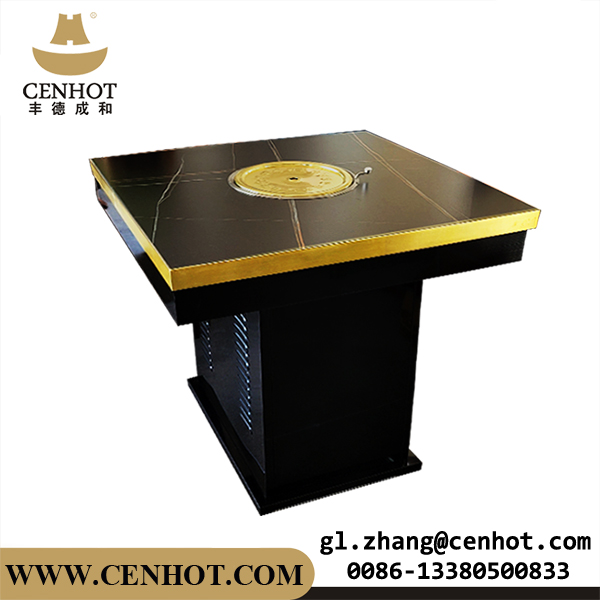
What Is a Smokeless Korean BBQ Table?
A smokeless Korean BBQ table is specially designed with a built-in smoke exhaust system. Instead of letting smoke spread throughout the restaurant, the table captures and filters it immediately. Depending on the design, the system can include:Korean BBQ pipes: Overhead pipes that draw smoke directly from the grill.
Under-table smoke purifiers: Hidden units beneath the table that suck in smoke and filter grease, keeping the restaurant air fresh.
These designs create a clean, comfortable dining environment while keeping the interior stylish.
How Do Smokeless BBQ Tables Work?
The working principle is simple but effective:Grill Placement – A charcoal, gas, or electric grill is installed in the center of the table.
Airflow System – As food is grilled, smoke is captured by either the overhead pipe or the under-table suction system.
Filtration & Ventilation – The smoke passes through filters that trap grease and odors, before being vented outside or purified for recirculation.
By controlling smoke at the source, the system prevents the strong smell of BBQ from clinging to clothes and improves indoor air quality.
Why Restaurants Need Smokeless Korean BBQ Tables
1. Better Customer ExperienceDiners can enjoy grilling without worrying about smoke in their eyes or leaving the restaurant smelling like BBQ. This comfort makes them more likely to stay longer and return.
2. Clean and Modern Atmosphere
Smokeless systems help maintain a clean interior, protecting walls, ceilings, and furniture from grease buildup. A sleek design with hidden purifiers also enhances the restaurant’s look.
3. Compliance With Regulations
Many cities have strict rules on restaurant ventilation. Smokeless Korean BBQ tables meet these standards by reducing smoke emissions.
4. Cost Savings in the Long Run
While the initial investment may seem high, smokeless BBQ tables reduce cleaning, maintenance, and HVAC costs. They also protect equipment and furniture from damage.
5. Competitive Advantage
With more restaurants competing in the BBQ and hot pot market, offering a smoke-free dining environment helps your business stand out and attract customers.
Choosing the Right Smokeless Korean BBQ Table
When selecting smokeless tables for your restaurant, consider:- Type of grill (charcoal, gas, or electric)
- Ventilation style (overhead pipe vs. under-table purifier)
- Table size and seating capacity
- Ease of installation and maintenance
Working with a reliable supplier ensures that your tables meet safety standards and fit your restaurant’s design.
Smokeless Korean BBQ tables are more than just a trend—they are a smart investment for restaurant owners. They improve air quality, enhance customer comfort, and keep your restaurant clean and modern.
If you are planning to open or upgrade a BBQ restaurant, choosing smokeless Korean BBQ equipment is one of the best decisions you can make.
Want to learn more about BBQ grills and restaurant equipment? Click here to explore our full range of Korean BBQ solutions.
The rapid rise in demand for sugarcane food packaging is driving manufacturers to innovate and expand production. From raw material sourcing to final packaging, factories play a crucial role in ensuring the quality, sustainability, and affordability of sugarcane bagasse plates, bowls, trays, and bagasse take out containers.

1. Automation and Efficiency
Modern factories are integrating automated production lines to increase efficiency and reduce costs. This allows them to scale up production while maintaining high quality.
2. Sustainability in Manufacturing
Leading sugarcane bagasse tableware manufacturers focus on waste reduction, energy-efficient machinery, and water recycling to further minimize environmental impact.
3. Quality Control
sincerepacking Factories implement strict quality control measures to ensure that each batch of sugarcane bagasse tableware meets safety and durability standards.
As demand for sustainable products grows, factories and manufacturers will continue to drive innovations in sugarcane bagasse tableware, ensuring a future where disposable products are both functional and environmentally responsible.
I see that EVOH film is important for colostomy and ostomy bags. When I use a product like Colostomy Bag Film from xhpak, I feel sure because the film stops smells and wetness. The film has many layers made of PE and EVOH. It works better than films with only one PE layer. This design helps me feel good, clean, and not worried every day.
Key Takeaways
-
EVOH film stops smells and water from getting out. This keeps ostomy bags fresh and skin dry. - Multilayer EVOH and PE films are strong and bend easily. They also block things from passing through. - EVOH film helps stop leaks and makes the bag comfy and quiet. - Bags with EVOH film can be made to fit well. They help protect skin that is sensitive. - Picking EVOH film bags helps people feel sure and comfy each day.
EVOH Film in Ostomy Bags
Barrier Properties
I want my ostomy bag to feel safe and comfy. EVOH film helps a lot with this. It acts like a shield and stops gases and wetness from getting out. This keeps my skin dry and helps stop leaks. I read that studies show using EVOH resin in pouches cuts down odor by 85%. The pouch also lasts longer and feels better, with a 40% longer wear time.
The EVOH Ostomy Film from xhpak has many layers. EVOH is the main barrier layer. The outside layer is polyethylene, which protects the film. The inside layer is soft on my skin. The EVOH layer is in the middle and blocks gases and other stuff. The thickness of the EVOH layer is checked carefully. This gives me strong protection and lets the bag bend easily.
Note: EVOH films follow strict safety rules in North America and Europe. These places want safe, high-quality medical products. EVOH does not use plasticizers, so it stops chemicals from moving into the bag. This makes it a good choice for sensitive uses like ostomy bags.
I like to compare EVOH films to other materials. The table below shows how EVOH films do against other barrier films for oxygen and moisture:
|
Film Type/Example |
Thickness (µm) |
Oxygen Permeability at 0% RH (ml/d·m²·bar) |
Oxygen Permeability at 100% RH (ml/d·m²·bar) |
MVTR (g/d·m²) |
|---|---|---|---|---|
|
EVOH-based multilayer films (Examples 1,4,5,6) |
55-100 |
Very low (3.7 - 6.9) |
Moderate increase (80 - 135) |
Moderate (16 - 25.5) |
|
EVOH-based multilayer films (Examples 2,3) |
70-75 |
Higher (34 - 37) |
Higher (155 - 191) |
Moderate (15 - 29) |
|
Comparative chlorine-free materials (Comp. Examples 2,3) |
73-75 |
Low (3.5 - 4.8) |
Very high (264 - 316) |
High (34.2 - 41) |
|
PVDC-based films (Comp. Example 1) |
75 |
Moderate (50) |
Low (<50) |
Low (10) |

EVOH films let in very little oxygen when it is dry. Even if it gets humid, EVOH still works better than many chlorine-free films. This means my ostomy bag works well in different places.
Odor and Moisture Control
Stopping bad smells is really important to me. I want to feel sure of myself at home and outside. EVOH film is great at blocking odors. Many ostomy bags, like EVOH Ostomy Film, use EVOH film to keep smells inside. Makers often add charcoal or carbon filters with EVOH film. These filters trap smells and stop them from leaking.
-
EVOH film is a main material in bags made to block smells.
-
Some bags have carbon filters to stop bad odors.
-
EVOH film works with sticky adhesives and hydrocolloid layers to keep smells in.
-
The multi-layer design, with EVOH in the middle, helps me avoid embarrassing times.
EVOH film also helps control wetness. It keeps the skin around my stoma dry. This protects my skin and lowers the chance of getting sore. EVOH film lets less moisture through than many chlorine-free films. This means my skin stays healthier.
When I use ostomy bags with EVOH film, I feel safer. The strong barrier keeps smells and wetness inside. This makes me feel calm. I trust ostomy barrier film from xhpak because it uses smart design and good materials to help me every day.
Multilayer Structure
When I touch my ostomy bag, it feels thin and bends easily. This is because it has many layers. My Ostomy Pouch Film from xhpak uses a PE/EVOH/PE design. The film has different layers, and each one does something special. The EVOH layer is in the middle. It stops oxygen and smells from getting out. The PE layers are on the outside. They make the film strong and keep water away from the EVOH.
Here is a table that shows the usual layers and how thick they are:
|
Layer Type |
Typical Thickness Range (µm) |
Composition Details |
|---|---|---|
|
Barrier |
2 to 6 |
Amorphous polyamide resin blended with maleic anhydride modified olefins |
|
Tie Layers |
2 to 6 (each) |
Maleic anhydride grafted resins, ethylene-based or propylene-based copolymers |
|
Inner Layers |
6 to 24 (each) |
Ethylene propylene copolymer, ethylene-octene based resins, or blends |
|
Skin Layers |
6 to 30 (each) |
Ethylene vinyl acetate, ethylene methyl acrylate copolymers, polypropylene-based resins and blends |
|
Total Film |
30 to 130 |
Skin and inner layers make up most of the thickness |
This design helps my bag stay strong and bendy. The EVOH layer keeps out gases. The PE layers help the film stay tough and safe from water. I feel good knowing my bag uses this smart design.
Comfort and Skin-Friendliness
Comfort is important to me every day. The inside layer of my Colostomy Bag Film EVOH Ostomy Film PE Ostomy Bag Film feels soft on my skin. The film bends with my body, so it does not poke or scratch. The skin layer uses gentle stuff that helps stop my skin from getting sore. My skin stays healthy, even if I wear the bag for a long time.
The film also sticks well. I trust the bag to stay put and not leak. The many layers make the film strong but not stiff. I can move, sit, and sleep without feeling bad.
Tip: I always make sure my ostomy bag has many layers. This helps keep my skin safe and makes me comfy all day.
Noise Reduction
I want my bag to be quiet. The many layers in my Colostomy Bag Film EVOH Ostomy Film PE Ostomy Bag Film help stop noise. The soft layers keep the film from making loud sounds when I move. I feel better in public because my bag stays quiet. The film’s design lets me do things without people noticing.
-
Soft layers inside and outside help stop sound
-
The film bends quietly with my body
-
I can wear my bag anywhere and feel safe
The special film from xhpak helps me feel calm. I know my bag is strong, comfy, and quiet.
EVOH vs. PE Films
Material Comparison
When I look at the materials in my ostomy bag, I notice that EVOH and PE each have special roles. EVOH stands out because it blocks oxygen and odors very well. This happens because EVOH has a unique structure made from ethylene and vinyl alcohol. These parts bond tightly, making it hard for gases and smells to pass through. I like that EVOH keeps my bag fresh and stops embarrassing odors.
PE, or polyethylene, feels soft and flexible. It does not block gases as well as EVOH, but it keeps moisture out. PE also makes the bag comfortable against my skin. I see that the best ostomy bags use both EVOH and PE together. EVOH sits in the middle as a thin barrier, while PE covers the outside and inside. This design protects the EVOH from moisture, which can weaken its barrier. The PE layers also add strength and help the bag stay quiet when I move.
EVOH films look shiny and clear. They do not attract dust, so my bag stays clean. PE gives the bag its toughness and helps it bend without breaking. When I use a bag with both EVOH and PE, I get the best of both worlds: strong odor control and comfort.
Application Differences
I want my ostomy bag to last and feel good all day. The way EVOH and PE work together makes this possible. EVOH alone feels stiff and can break easily. PE alone is soft and tough but does not stop odors well. When combined, they create a film that is strong, flexible, and blocks both moisture and smells.
Here is a table that shows how EVOH, PE, and their combination compare:
|
Property |
EVOH Films (Pure) |
PE Films (LLDPE, ULDPE) |
EVOH/PE Laminates (Multilayer) |
|---|---|---|---|
|
Tensile Strength at Break |
Brittle, cracks easily |
Tough, flexible |
>10 MPa, up to 40 MPa |
|
Elongation at Break |
Low, breaks like glass |
Very high |
>200%, up to 800% |
|
Flexibility |
Stiff and brittle |
Very flexible |
Improved, bends easily |
|
Impact Resistance |
Poor |
Good |
No break in impact tests |
|
Odor Barrier |
Excellent |
Poor |
Excellent |
|
Moisture Barrier |
Moderate |
Excellent |
Excellent |
I notice that pure EVOH is not strong enough for daily use. PE adds the needed toughness and flexibility. When I use a multilayer film, I get a bag that does not leak, feels soft, and stays quiet. Clinical studies show that EVOH reduces odor by 85% and increases wear time by 40%. This makes me feel more confident and comfortable.
Tip: I always choose ostomy bags that use both EVOH and PE in a multilayer design. This way, I get the best protection and comfort every day.
Performance and Customization
Leak Prevention
I want my ostomy bag to stop leaks. My xhpak EVOH Ostomy Film helps me feel safe. The EVOH film is a strong barrier. It keeps smells and wetness inside the bag. There are many things that help stop leaks:
-
The film is very strong, so it does not break or rip.
-
A carbon filter inside the bag catches bad smells and keeps them in.
-
The snap ring holds the bag close to my skin, so leaks do not happen.
-
Buckle strap holes let me use a belt for more support, so the bag stays put.
-
The skin barrier uses special hydrocolloid that sticks well and keeps my skin safe.
-
The bag has a big sticky area and two layers of soft fabric, so it feels nice and does not leak.
I trust these features to keep my skin dry and my clothes clean. The bag is one piece and fits close to my body. The soft hydrocolloid glue does not leave a mess, even after wearing it for a long time. The soft fabric on both sides feels good and stops rubbing, which helps stop leaks by making the bag comfy.
Makers test EVOH films for how much air and water can get through, how strong they are, and how well they seal. They use special tools to make sure the film is good enough. This testing makes sure my bag will not let me down when I need it.
Custom Fit and Safety
Everyone’s body is different, so I like that my bag can be changed to fit me. Barrier rings fill in bumpy skin around my stoma. This makes a flat spot and stops leaks. Rings like CeraRing™ bend and come in many shapes and sizes. They keep my skin safe and help the bag fit better.
Barrier extenders hold the skin barrier in place and stop the edges from coming up. I can use three extenders for a better fit. These extenders, like CeraPlus™, are soft and bendy, so they move with me. Many people, like me, think these extras are important for feeling safe and sure.
Here is a table that shows some ways I can change my bag:
|
Customization Aspect |
Details |
|---|---|
|
Film Material |
Multi-layer EVOH high-barrier film for odor and leak control |
|
Size Compatibility |
Adult and child sizes available |
|
Shape and Color Options |
Many shapes and colors to choose from |
|
Closure Options |
Clip, Velcro, or aluminum strip closures |
|
Optional Covers |
Non-woven or PE mesh covers for extra comfort |
|
Filters and Accessories |
Customizable to fit my needs |
With these choices, I can make a pouch system that fits my life. I feel safe, comfy, and ready for anything each day.
I trust my xhpak ostomy bag because EVOH film blocks smells and wetness. The bag has many layers. These layers keep my skin safe and make the bag comfy. Studies say these films are strong, soft, and clean:
|
Feature |
Benefit |
|---|---|
|
Odor Barrier |
Keeps smells inside |
|
Comfort |
Soft, flexible, and quiet |
|
Hygiene |
Waterproof and safe for my skin |
I always pick good materials. Good film helps stop leaks and keeps my skin healthy. I feel sure when my bag fits right and keeps me safe every day.
FAQ
What makes xhpak EVOH film special for ostomy bags?
I trust xhpak EVOH film because it blocks odors and moisture better than regular films. The multilayer design keeps my skin dry and helps me feel confident every day.
Can I cut the film to fit my stoma size?
Yes, I can trim the film to fit my stoma. The film stays strong and does not tear easily. I always follow the instructions for the best fit and comfort.
Is EVOH film safe for sensitive skin?
I have sensitive skin, so I look for films that feel soft and gentle. EVOH film in my bag does not irritate my skin. The smooth inner layer helps protect me from redness and soreness.
How does EVOH film help with odor control?
EVOH film acts as a strong barrier. It traps odors inside the bag. I notice a big difference in confidence when I use bags with EVOH film.
Can I wear my ostomy bag while swimming or showering?
Yes, I wear my bag in water. The EVOH film and strong seals keep water out. My bag stays secure and comfortable, even when I swim or shower.
Production of small instruments, transparent insulating parts and impact-resistant parts.
3, Used to produce all kinds of electrical insulation materials, such as wires, switches, electrical enclosures.
Production of wear-resistant wear parts, transmission parts, and chemical, instrumentation and other parts.
Made of heat-resistant parts, insulating parts, anti-wear wear parts, transmission parts, medical and electronic components; can be used for higher temperatures gears, blades, valves and other parts, can be used instead of stainless steel; Parts and connectors; motor, rotor, chassis, transformer electrical parts.
jythermofilm Related reading:Nylon Thermoforming Film,PA Base Film,Packaging Films Manufacturer.
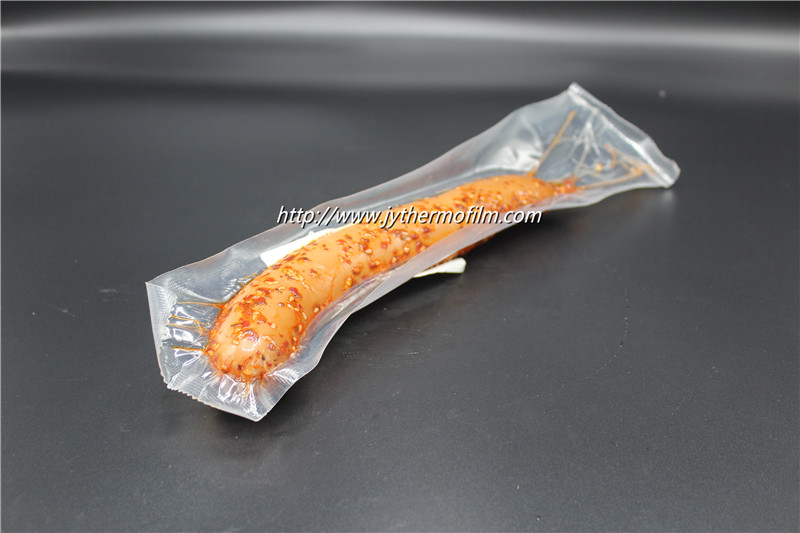
- Buddha Jump Over the Wall1
- Canned Abalone2
- Canned Turtle Soup1
- Edible Bird's Nest2
- Frozen Foods1
- Frozen Seafood8
- Jelly/Pudding Applications1
- Meat Product Applications2
- Others Applications5
- Plant-based meat Product Applications1
- SURIMI2
- Soft Candy1
- Soft Candy Applications4
- bottle1
- can end2
- packaging film2
- tableware3



